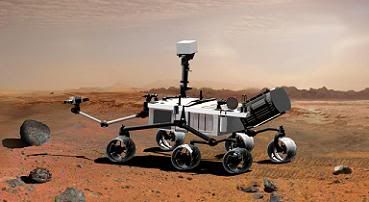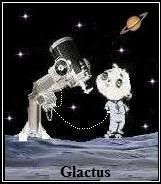Post by glactus on Nov 23, 2011 0:32:56 GMT
Maybe because it appears as a speck of blood in the sky, the planet Mars was named after the Roman god of war. From the point of view of life as we know it, that's appropriate. The Martian surface is incredibly hostile for life. The Red Planet's thin atmosphere does little to shield the ground against radiation from the Sun and space.

The planet Mars
Harsh chemicals, like hydrogen peroxide, permeate the soil. Liquid water, a necessity for life, can't exist for very long here-any that does not quickly evaporate in the diffuse air will soon freeze out in subzero temperatures common over much of the planet.

The Valles Marineris chasm
It wasn't always this way. There are signs that in the distant past, billions of years ago, Mars was a much more inviting place. Martian terrain is carved with channels that resemble dry riverbeds. Spacecraft sent to orbit Mars have identified patches of minerals that form only in the presence of liquid water. It appears that in its youth, Mars was a place that could have harbored life, with a thicker atmosphere warm enough for rain that formed lakes or even seas.

The Mars rover Curiosuty
Two new NASA missions, one that will roam the surface and another that will orbit the planet and dip briefly into its upper atmosphere, will try to discover what transformed Mars. "The ultimate driver for these missions is the question, did Mars ever have life?"
"Did microbial life ever originate on Mars, and what happened to it as the planet changed? Did it just go extinct, or did it go underground, where it would be protected from space radiation and temperatures might be warm enough for liquid water?"
To search for answers, the Mars Science Laboratory mission features Curiosity, the largest and most advanced rover ever sent to the Red Planet will be launched this week.The Curiosity rover bristles with multiple cameras and instruments, including Goddard's Sample Analysis at Mars instrument suite.
To see 6 minute and 30 second video of life on Mars just click on the link below. Has sound. Full screen option bottom right.
www.youtube.com/watch?feature=player_detailpage&v=Su4dxYL9ZMI

Credits: These are non copywrite images.
Text: This is part text only. See full text and all scientists involved at Space daily.com
www.marsdaily.com/reports/New_Missions_To_Investigate_How_Mars_Turned_Hostile_999.html

The planet Mars
Harsh chemicals, like hydrogen peroxide, permeate the soil. Liquid water, a necessity for life, can't exist for very long here-any that does not quickly evaporate in the diffuse air will soon freeze out in subzero temperatures common over much of the planet.

The Valles Marineris chasm
It wasn't always this way. There are signs that in the distant past, billions of years ago, Mars was a much more inviting place. Martian terrain is carved with channels that resemble dry riverbeds. Spacecraft sent to orbit Mars have identified patches of minerals that form only in the presence of liquid water. It appears that in its youth, Mars was a place that could have harbored life, with a thicker atmosphere warm enough for rain that formed lakes or even seas.

The Mars rover Curiosuty
Two new NASA missions, one that will roam the surface and another that will orbit the planet and dip briefly into its upper atmosphere, will try to discover what transformed Mars. "The ultimate driver for these missions is the question, did Mars ever have life?"
"Did microbial life ever originate on Mars, and what happened to it as the planet changed? Did it just go extinct, or did it go underground, where it would be protected from space radiation and temperatures might be warm enough for liquid water?"
To search for answers, the Mars Science Laboratory mission features Curiosity, the largest and most advanced rover ever sent to the Red Planet will be launched this week.The Curiosity rover bristles with multiple cameras and instruments, including Goddard's Sample Analysis at Mars instrument suite.
To see 6 minute and 30 second video of life on Mars just click on the link below. Has sound. Full screen option bottom right.
www.youtube.com/watch?feature=player_detailpage&v=Su4dxYL9ZMI
Credits: These are non copywrite images.
Text: This is part text only. See full text and all scientists involved at Space daily.com
www.marsdaily.com/reports/New_Missions_To_Investigate_How_Mars_Turned_Hostile_999.html


